Regional Controls on Climate and Weather Variability on the Southwest Coast of Peru
Abstract
1. Introduction and Background
2. Data and Methods
3. Results
Climate and Seasonality
4. Regional Teleconnections
5. Winter Showers in July 2002 and 2009
6. Dry Spell in November 2020
7. Concluding Discussion
Funding
Institutional Review Board Statement
Informed Consent Statement
Data Availability Statement
Acknowledgments
Conflicts of Interest
Appendix A
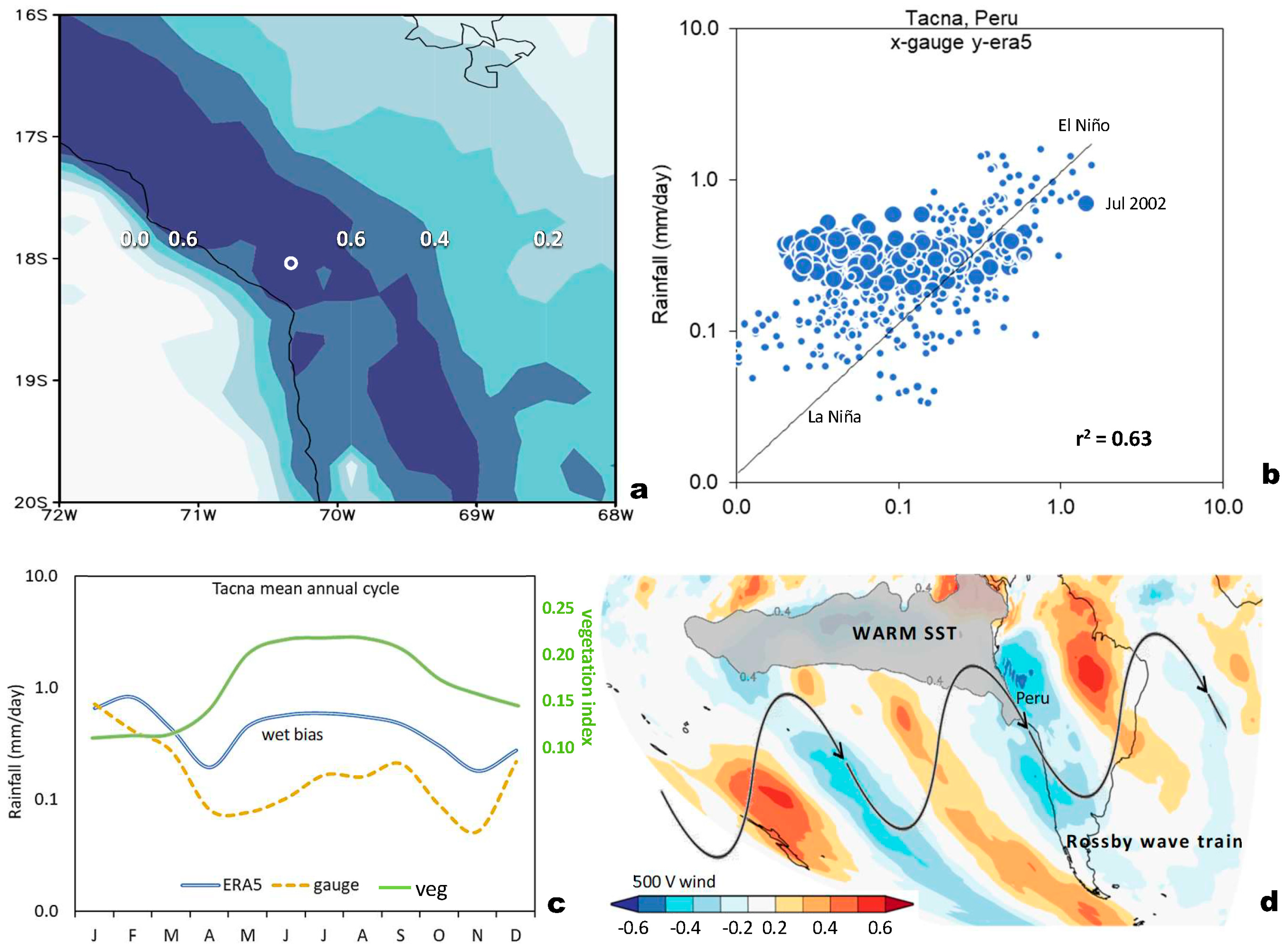
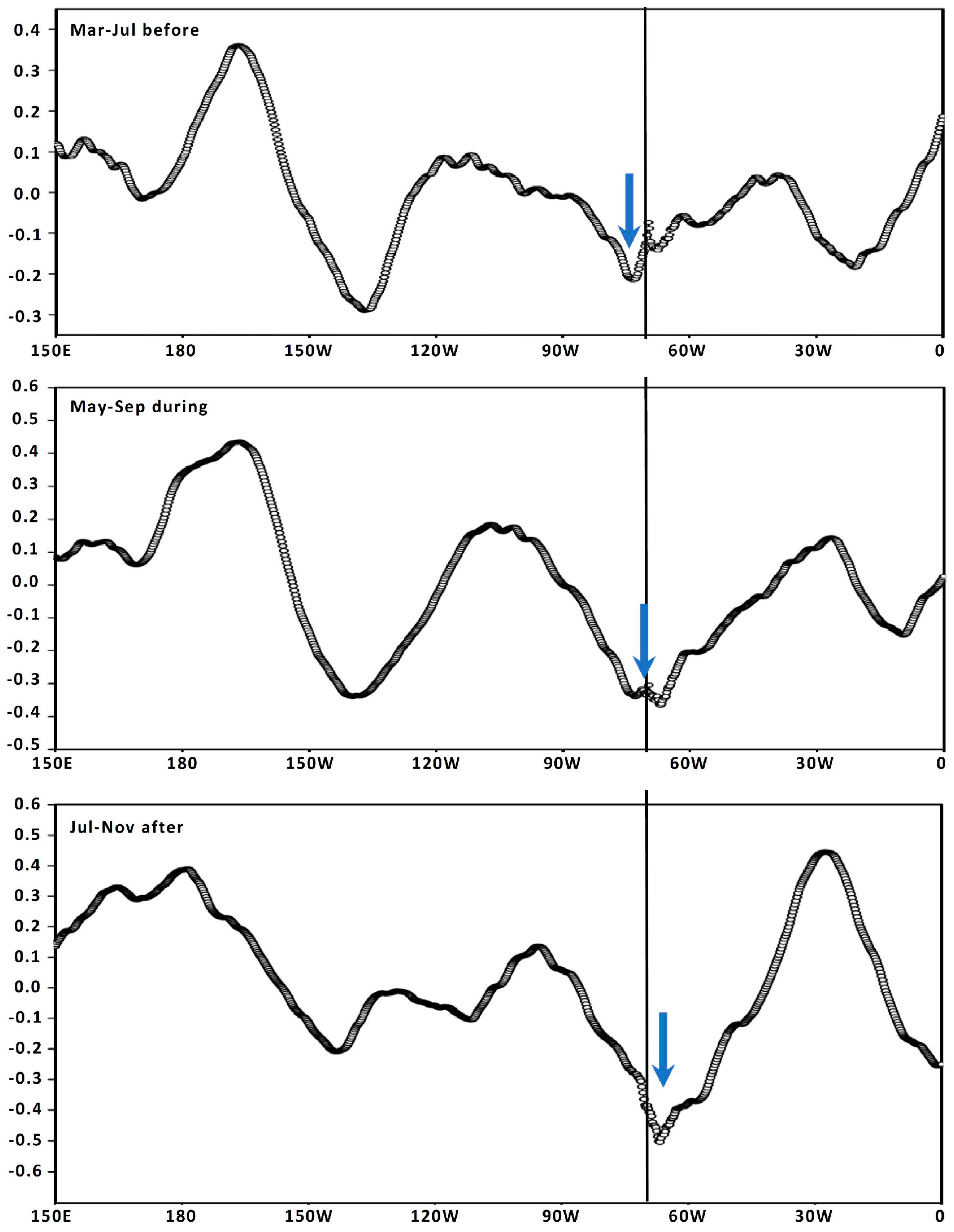
References
- Drenkhan, F.; Carey, M.; Huggel, C.; Seidel, J.; Oré, M.T. The changing water cycle: Climatic and socioeconomic drivers of water-related changes in the Andes of Peru. Wiley Interdiscip. Rev. Water 2015, 2, 715–733. [Google Scholar] [CrossRef]
- Bradley, R.; Vuille, M.; Diaz, H.; Vergara, W. Threats to water supplies in the tropical Andes. Science 2006, 312, 1755–1756. [Google Scholar] [CrossRef] [PubMed]
- Eda, L.E.H.; Chen, W. Integrated water resources management in Peru. Procedia Environ. Sci. 2010, 2, 340–348. [Google Scholar] [CrossRef]
- Lettau, H. Dynamic and energetic factors which cause and limit aridity along South America’s Pacific coast. World Surv. Climatol. 1976, 12, 188–192. [Google Scholar]
- Rutllant, J. On the Extreme Aridity of Coastal and Atacama Deserts in Northern Chile. Ph.D. Thesis, Department of Meteorology, University of Wisconsin, Madison, WI, USA, 1977; 175p. [Google Scholar]
- Rutllant, J.; Ulriksen, P. Boundary layer dynamics of the extremely arid northern part of Chile. Bound. Layer Meteorol. 1979, 17, 41–55. [Google Scholar] [CrossRef]
- de Abreu, M.L.; Bannon, P. Dynamics of the South American coastal desert. J. Atmos. Sci. 1993, 50, 2952–2964. [Google Scholar] [CrossRef]
- Ramos, I.; Aliaga-Nestares, V.; Castro, A. Heavy snowfalls in the Peruvian Andes: The wettest winter of the last 19 years, in State of the Climate 2018. Bull. Am. Meteorol. Soc. 2019, 100, S203–S221. [Google Scholar]
- Bozkurt, D.; Rondanelli, R.; Garreaud, R.; Arriagada, A. Impact of warmer eastern tropical Pacific SST on the March 2015 Atacama floods. Mon. Weather Rev. 2016, 144, 4441–4460. [Google Scholar] [CrossRef]
- Montecinos, A.; Aceituno, P. Seasonality of the ENSO-related rainfall variability in central Chile and associated circulation anomalies. J. Clim. 2003, 16, 281–296. [Google Scholar] [CrossRef]
- Reyers, M.; Boehm, C.; Knarr, L.; Shao, Y.; Crewell, S. Synoptic-to-regional-scale analysis of rainfall in the Atacama Desert (18-26S) using a long-term simulation with WRF. Mon. Weather Rev. 2020, 149, 91–112. [Google Scholar] [CrossRef]
- Böhm, C.; Schween, J.H.; Reyers, M.; Maier, B.; Löhnert, U.; Crewell, S. Toward a climatology of fog frequency in the Atacama Desert via multispectral satellite data and machine learning techniques. J. Appl. Meteor. Climatol. 2021, 60, 1149–1169. [Google Scholar]
- Moat, J.; Orellana-Garcia, A.; Tovar, C.; Arakaki, M.; Arana, C.; Cano, A.; Faundez, L.; Gardner, M.; Hechenleitner, P.; Hepp, J.; et al. Seeing through the clouds–Mapping desert fog oasis ecosystems using 20 years of MODIS imagery over Peru and Chile. Int. J. Appl. Earth Obs. Geoinf. 2021, 103, 102468. [Google Scholar] [CrossRef]
- Pino, E.; Ramos, L.; Avalos, O.; Tacora, P.; Chávarri, E.; Angulo, O.; Ascensios, D.; Mejía, J. Factors affecting depletion and pollution by marine intrusion in the Yarada coastal aquifer of Tacna Peru. Technol. Sci. Water 2019, 10, 177–213. [Google Scholar]
- Huanacuni-Lupaca, C. Technical Report of the Water Resources Council for the Tacna Basin, Peru, 2021.
- Chucuya, S.; Vera, A.; Pino-Vargas, E.; Steenken, A.; Mahlknecht, J.; Montalván, I. Hydrogeochemical characterization and identification of factors influencing groundwater quality in the Tacna Peru coastal aquifer. Int. J. Environ. Res. Public Health 2022, 19, 2815. [Google Scholar] [CrossRef]
- Houston, J. Variability of precipitation in the Atacama Desert: Its causes and hydrological impact. Int. J. Climatol. 2006, 26, 2181–2198. [Google Scholar] [CrossRef]
- Vargas, G.; Rutllant JOrtlieb, L. ENSO tropical-extratropical climate teleconnections and mechanisms for Holocene debris flows along the hyperarid coast of western South America 17S–24S. Earth Planet. Sci. Lett. 2006, 249, 467–483. [Google Scholar] [CrossRef]
- Hersbach, H.; Bell, B.; Berrisford, P.; Hirahara, S.; Horányi, A.; Muñoz-Sabater, J.; Nicolas, J.; Peubey, C.; Radu, R.; Schepers, D.; et al. The ERA5 global reanalysis. Q. J. R. Meteo. Soc. 2020, 146, 1999–2049. [Google Scholar] [CrossRef]
- Hou, A.Y.; Kakar, R.K.; Neeck, S.; Azarbarzin, A.A.; Kummerow, C.D.; Kojima, M.; Oki, R.; Nakamura, K.; Iguchi, T. The Global Precipitation Measurement mission. Bull. Am. Meteorol. Soc. 2014, 95, 701–722. [Google Scholar] [CrossRef]
- Xiong, X.; Angal, A.; Chang, T.; Chiang, K.; Lei, N.; Li, Y.; Sun, J.; Twedt, K.; Wu, A. MODIS and VIIRS calibration and characterization in support of long-term high-quality data products. Remote Sens. 2020, 12, 3167. [Google Scholar] [CrossRef]
- Carton, J.A.; Chepurin, G.A.; Chen, L. SODA3: A new ocean climate reanalysis. J. Clim. 2018, 31, 6967–6983. [Google Scholar] [CrossRef]
- Rayner, N.A.A.; Parker, D.E.; Horton, E.B.; Folland, C.K.; Alexander, L.V.; Rowell, D.P.; Kent, E.C.; Kaplan, A. Global analyses of sea surface temperature, sea ice, and night marine air temperature since the late nineteenth century. J. Geophys. Res. 2003, 108, 4407. [Google Scholar] [CrossRef]
- Marchand, R.; Mace, G.G.; Ackerman, T.; Stephens, G. Hydrometeor detection using Cloudsat, an earth-orbiting 94-GHz cloud radar. J. Atmos. Ocean. Technol. 2008, 25, 519–533. [Google Scholar] [CrossRef]
- Stein, A.F.; Draxler, R.R.; Rolph, G.D.; Stunder, B.J.B.; Cohen, M.D.; Ngan, F. NOAA’s HYSPLIT atmospheric transport and dispersion modeling system. Bull. Am. Meteorol. Soc. 2015, 96, 2059–2077. [Google Scholar] [CrossRef]
- Zhang, T.; Hoell, A.; Perlwitz, J.; Eischeid, J.; Murray, D.; Hoerling, M.; Hamill, T.M. Towards probabilistic multi-variate ENSO monitoring. Geophys. Res. Lett. 2019, 46, 10532–10540. [Google Scholar] [CrossRef]
- Garreaud, R.; Muñoz, R. The diurnal cycle in circulation and cloudiness over the subtropical southeast Pacific: A modeling study. J. Clim. 2004, 17, 1699–1710. [Google Scholar] [CrossRef]
- Lou, J.; O’Kane, T.J.; Holbrook, N.J. Linking the atmospheric Pacific-South American mode with oceanic variability and predictability. Commun. Earth Environ. 2021, 2, 223. [Google Scholar] [CrossRef]
- Robertson, A.W.; Mechoso, C.R. Circulation regimes and low-frequency oscillations in the South Pacific sector. Mon. Weather Rev. 2003, 131, 1566–1576. [Google Scholar] [CrossRef]
- Bohm, C.; Reyers, M.; Knarr, L.; Crewell, S. The role of moisture conveyor belts for precipitation in the Atacama Desert. Geophys. Res. Lett. 2021, 48, e2021GL094372. [Google Scholar] [CrossRef]
- Vicencio-Veloso, J. Analysis of an extreme precipitation event in the Atacama desert in January 2020 and its relationship to humidity advection along the SE Pacific. Atmósfera 2022, 35, 421–448. [Google Scholar] [CrossRef]
- Solman, S.A.; Menendez, C.G. ENSO-related variability of the Southern Hemisphere winter storm track over the eastern Pacific–Atlantic sector. J. Atmos. Sci. 2002, 59, 2128–2140. [Google Scholar] [CrossRef]
- Sanabria, J.; Bourrel, L.; Dewitte, B.; Frappart, F.; Rau, P.; Solis, O.; Labat, D. Rainfall along the coast of Peru during strong El Niño events. Int. J. Climatol. 2018, 38, 1737–1747. [Google Scholar] [CrossRef]
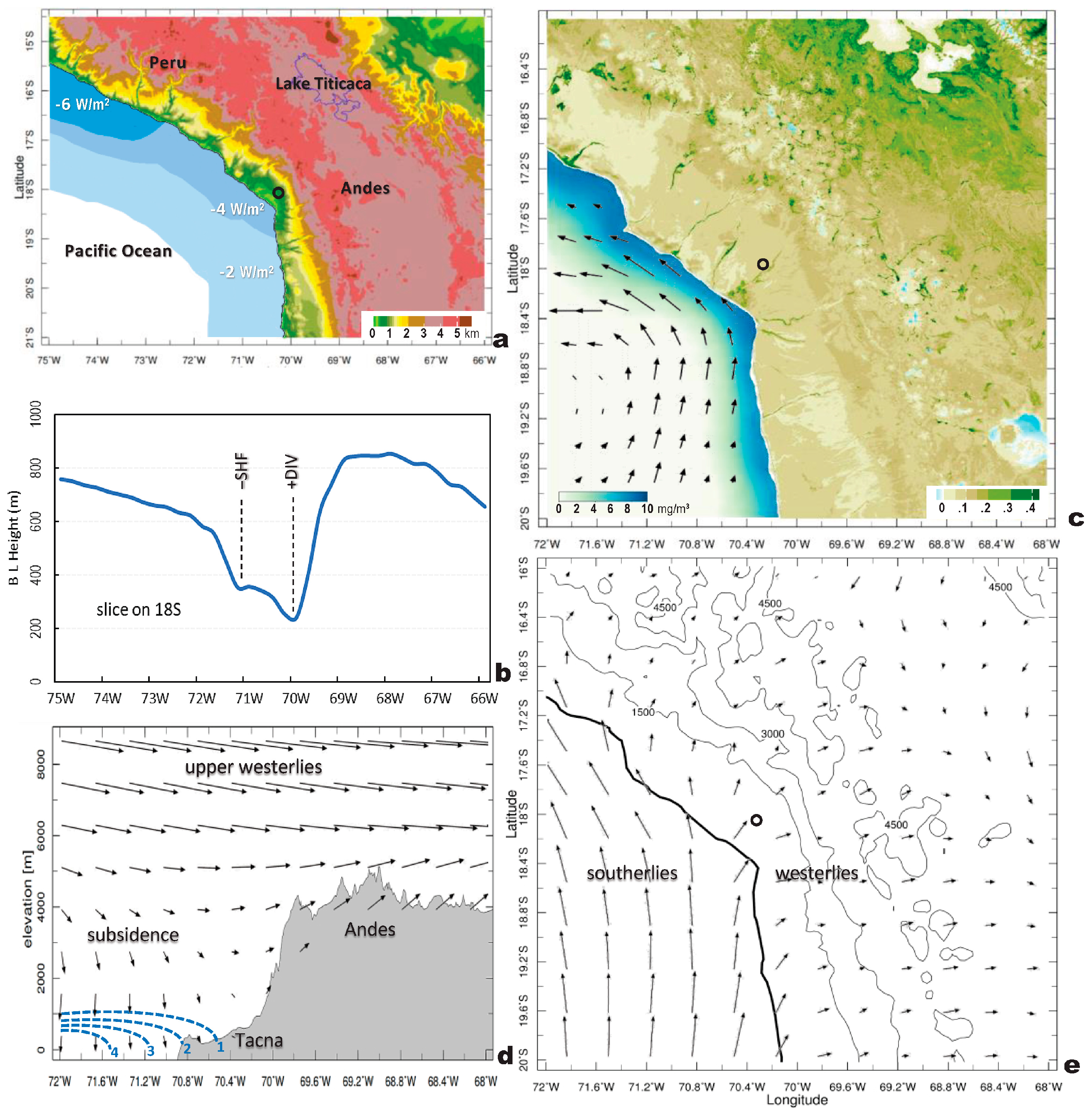
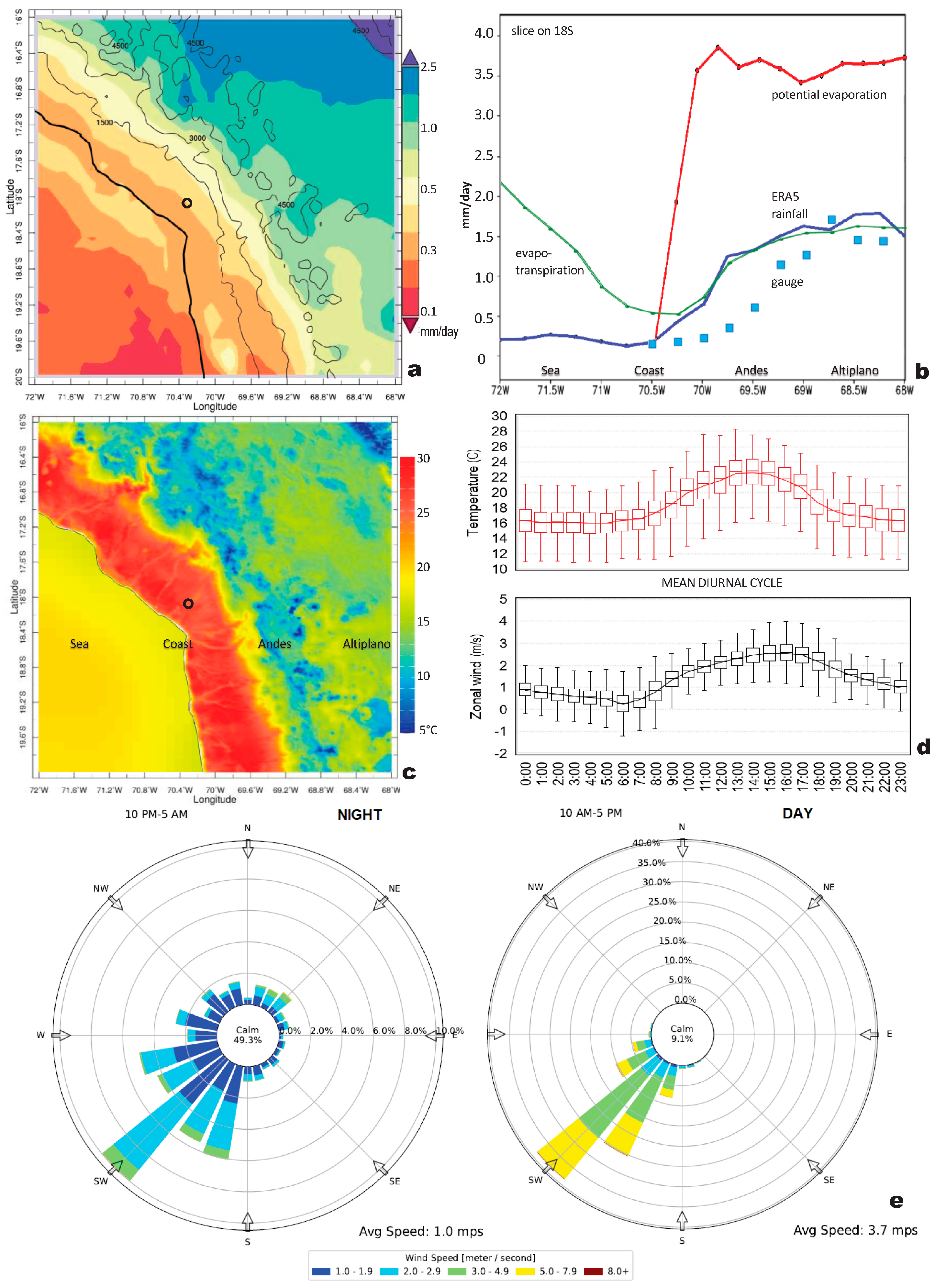
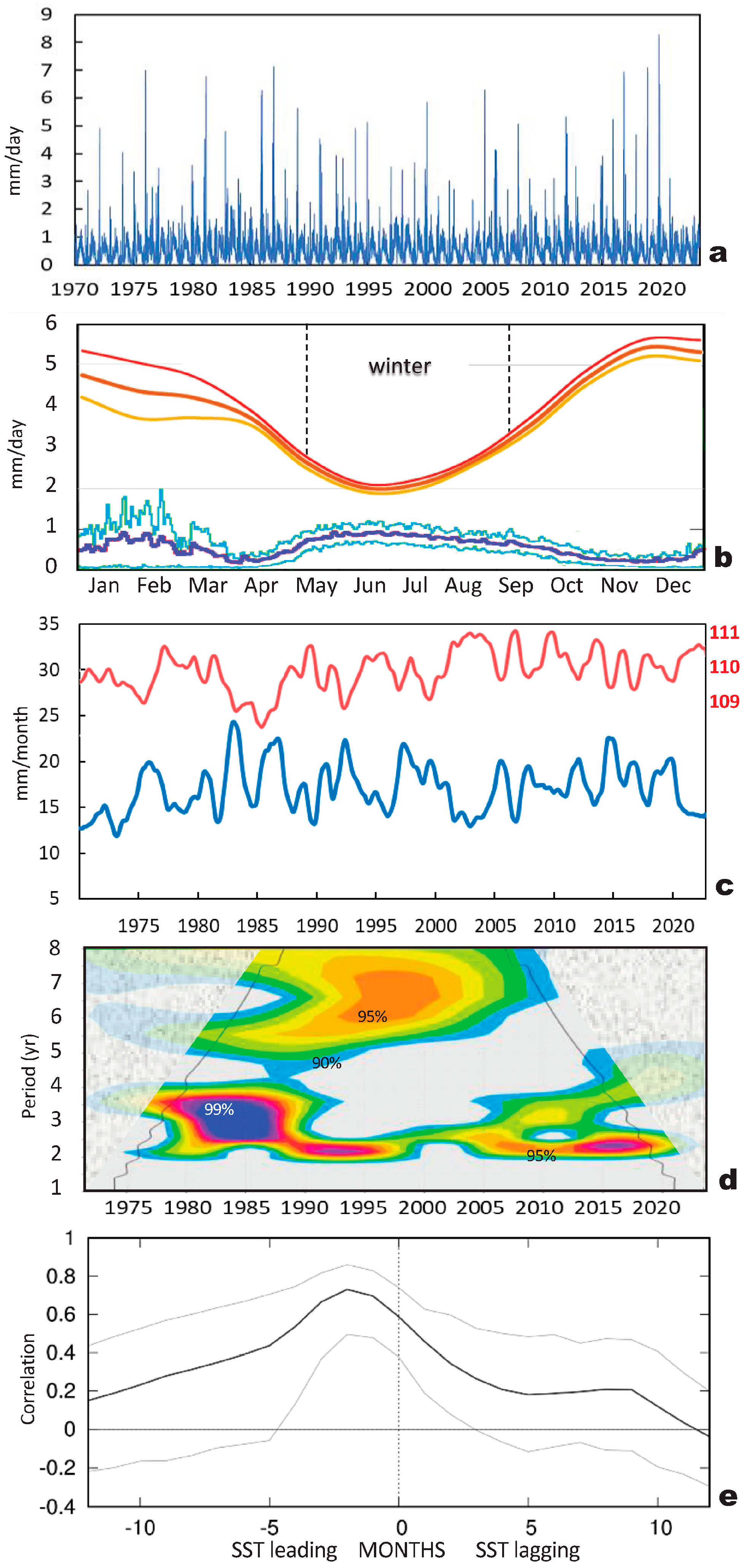

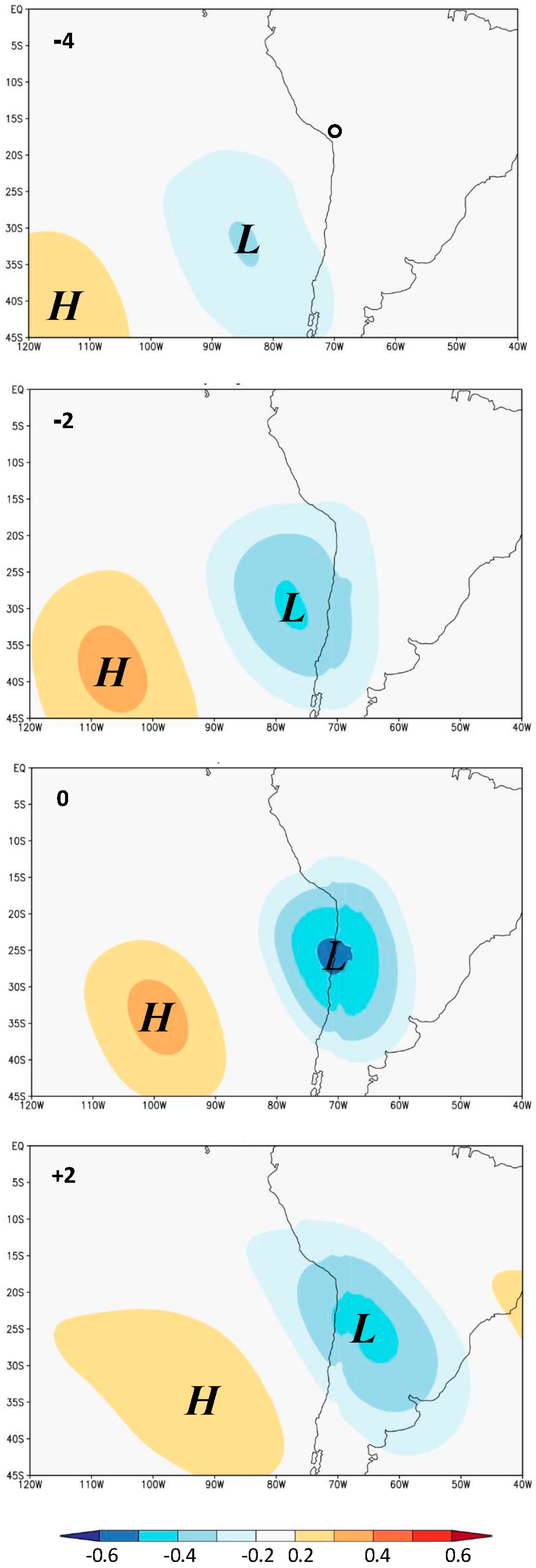
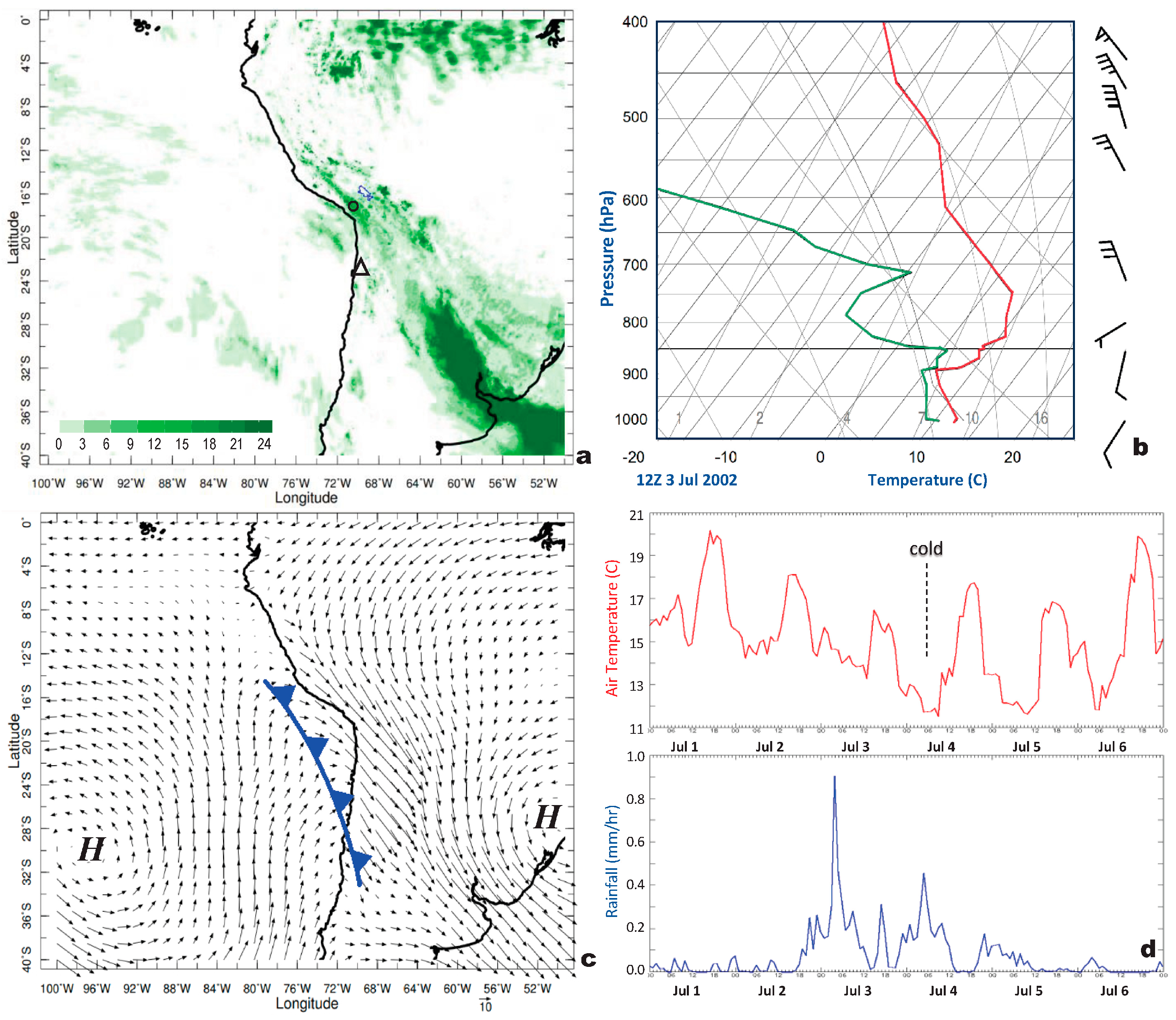
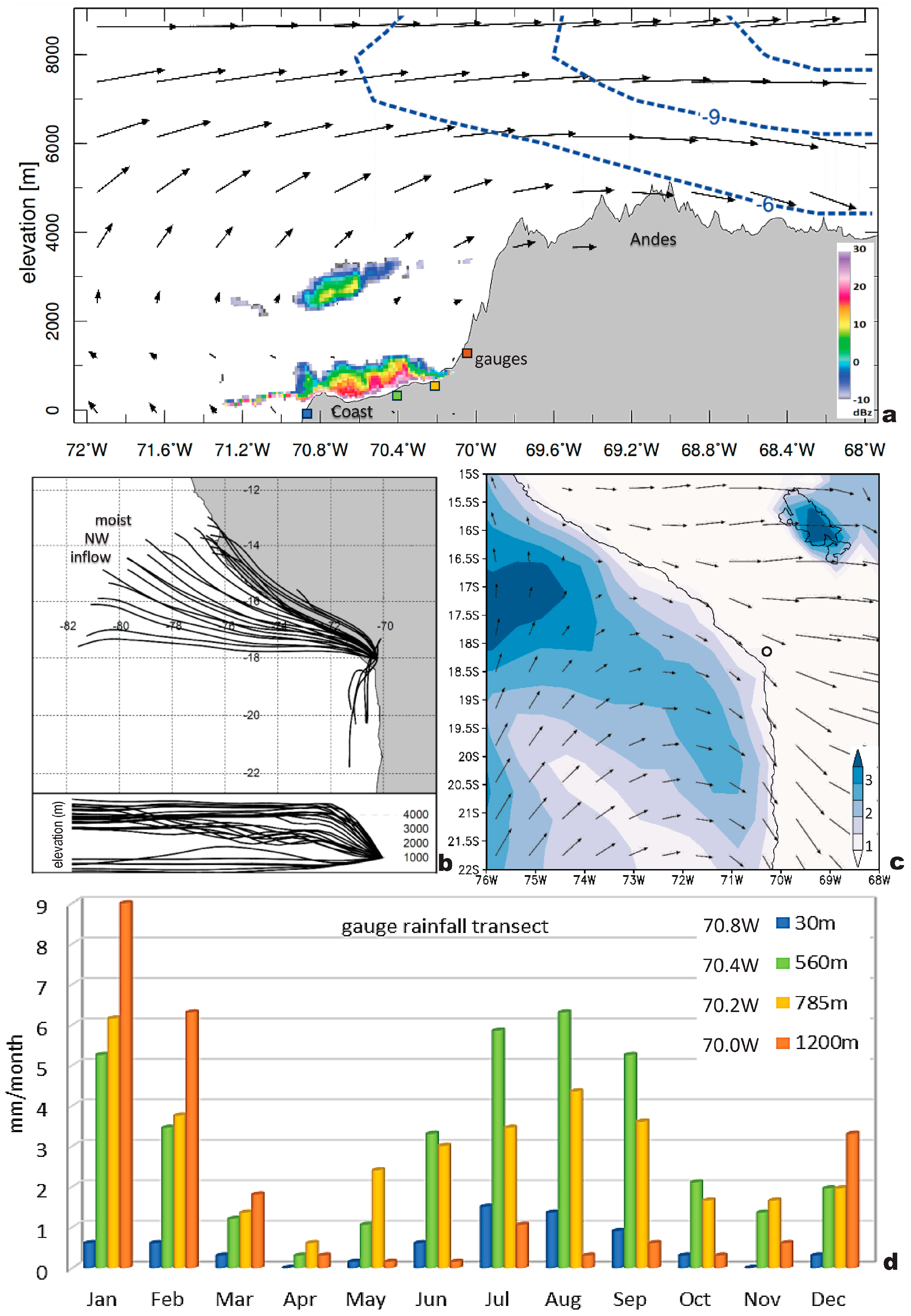
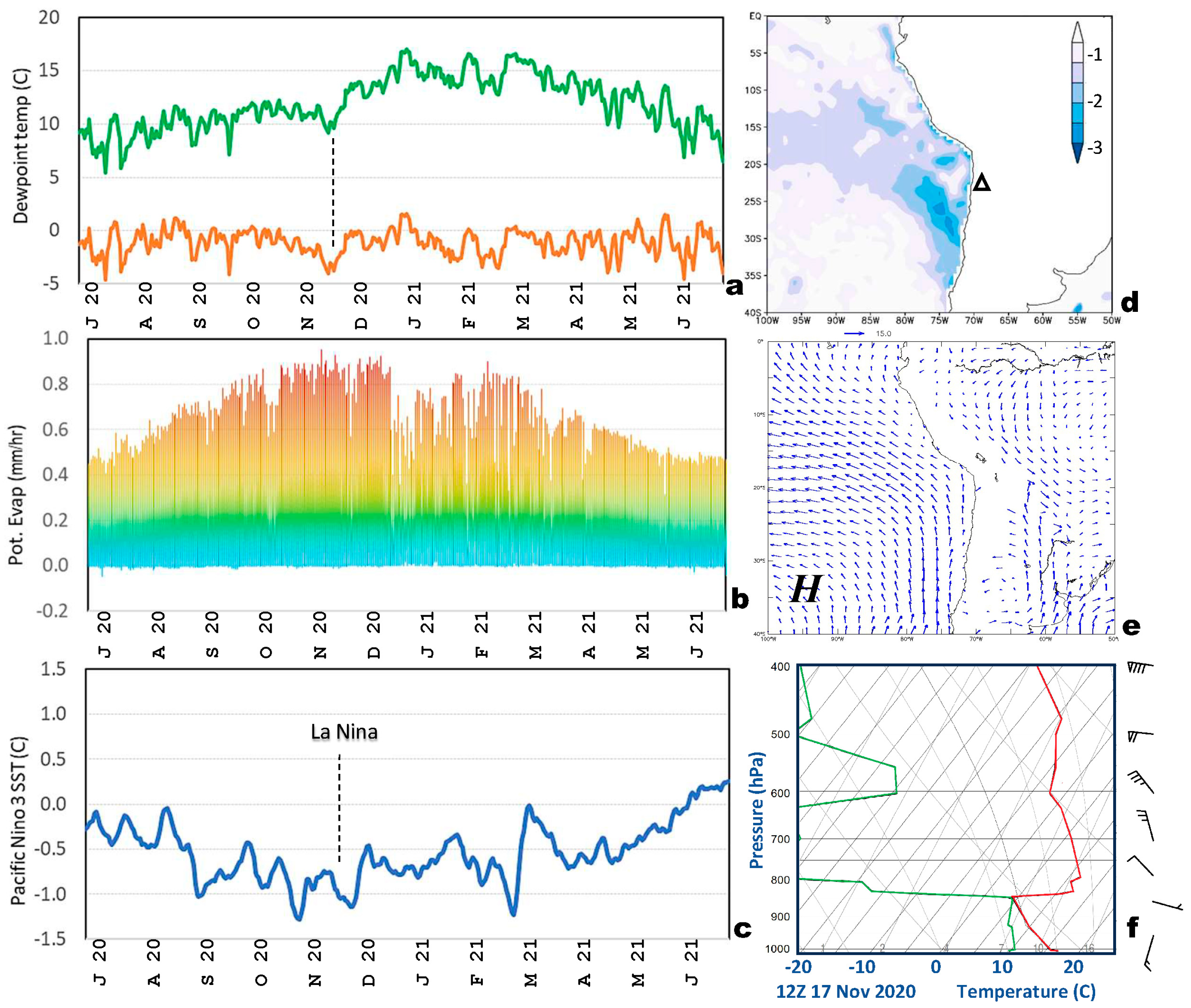
| Acronym | Name (Variables) | Horz. Res. | Reference Document |
|---|---|---|---|
| Cloudsat | Satellite microwave radar (cloud reflectivity) | 4 km | [24] |
| ERA5 | European Reanalysis v5 (geopt ht, temp, wind, vertical motion, humidity, pot. Evap, net OLR) | 25 km | [19] |
| GPM | Global Precipitation Monitoring (multi-satellite calibrated rainfall) | 10 km | [20] |
| HADLEY | Hadley Centre reanalysis (sea surface temperature) | 100 km | [23] |
| HYSPLIT | Hybrid Lagrangian Trajectory model (airflow) | 50 km | [25] |
| In-situ | Weather data around Tacna, Peru (gauge and station data, radiosonde profile) | point | Peru/Chile weather service |
| MODIS | Multi-spectral satellite imager (land/sea temperature and color) | 4 km | [21] |
| NOAA | ENSO variables (Nino3 SST) | 25 km | [26] |
| SODA | Simple Ocean Data Assimilation (near-surface currents) | 50 km | [22] |
| Year | Mon | Day | Amount |
|---|---|---|---|
| 1992 | 5 | 29 | 3.93 |
| 1992 | 5 | 28 | 3.34 |
| 1992 | 5 | 30 | 2.86 |
| 1976 | 8 | 25 | 2.79 |
| 2002 | 7 | 3 | * 2.72 |
| 1992 | 7 | 14 | 2.55 |
| 2002 | 7 | 4 | 2.52 |
| 1976 | 8 | 26 | 2.48 |
| 1993 | 7 | 5 | 2.41 |
| 2010 | 5 | 1 | 2.23 |
| 1993 | 7 | 4 | 2.18 |
| 2014 | 6 | 26 | 2.17 |
| 1992 | 7 | 13 | 2.15 |
| 1983 | 6 | 12 | 2.13 |
| 1976 | 8 | 24 | 2.12 |
| 2015 | 8 | 9 | 2.12 |
| 1983 | 5 | 15 | 2.1 |
| 1992 | 6 | 4 | 2.07 |
| 1983 | 5 | 14 | 2.01 |
| 1986 | 6 | 4 | 2.01 |
| 1992 | 6 | 29 | 2 |
| 1983 | 7 | 10 | 1.99 |
| 1983 | 8 | 28 | 1.98 |
| 1983 | 7 | 1 | 1.97 |
| 1983 | 8 | 29 | 1.94 |
| 1992 | 6 | 3 | 1.94 |
| 2005 | 9 | 14 | 1.93 |
| 1992 | 7 | 15 | 1.91 |
| 2002 | 7 | 2 | 1.9 |
| 2009 | 7 | 21 | * 1.90 |
| 1984 | 8 | 7 | 1.9 |
Disclaimer/Publisher’s Note: The statements, opinions and data contained in all publications are solely those of the individual author(s) and contributor(s) and not of MDPI and/or the editor(s). MDPI and/or the editor(s) disclaim responsibility for any injury to people or property resulting from any ideas, methods, instructions or products referred to in the content. |
© 2024 by the author. Licensee MDPI, Basel, Switzerland. This article is an open access article distributed under the terms and conditions of the Creative Commons Attribution (CC BY) license (https://creativecommons.org/licenses/by/4.0/).
Share and Cite
Jury, M.R. Regional Controls on Climate and Weather Variability on the Southwest Coast of Peru. Coasts 2024, 4, 49-62. https://doi.org/10.3390/coasts4010004
Jury MR. Regional Controls on Climate and Weather Variability on the Southwest Coast of Peru. Coasts. 2024; 4(1):49-62. https://doi.org/10.3390/coasts4010004
Chicago/Turabian StyleJury, Mark R. 2024. "Regional Controls on Climate and Weather Variability on the Southwest Coast of Peru" Coasts 4, no. 1: 49-62. https://doi.org/10.3390/coasts4010004
APA StyleJury, M. R. (2024). Regional Controls on Climate and Weather Variability on the Southwest Coast of Peru. Coasts, 4(1), 49-62. https://doi.org/10.3390/coasts4010004






